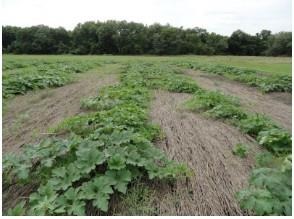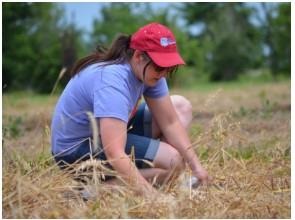In addition to the value of harvested pumpkins for commercial use (canned pumpkin, produce departments, etc.) pumpkins are also a staple crop in agritourism operations. In Kansas alone, there were 409 farms registered in the state in 2020. Agritourism enterprises have shown to benefits communities by connecting consumers with agriculture and helping preserve farmland in rural and peri-urban areas.
Vegetable crop production typically involves smaller acreages than agronomic production. However, farmers often rely on intensive cultivation of soil to prepare the seedbed for planting. Tilling also helps manage weeds.
Over time, extensive tillage can have negative effects on soil structure and microbial properties. Researchers in Kansas recently published a paper studying conservation practices for pumpkin production. The research was published in Soil Science Society of America Journal, a publication of the Soil Science Society of America.

A field planted with pumpkins grown in a cover crop system with cereal rye. Cover crops have proven environmental benefits, though many vegetable growers in the Midwest have been slower to adopt this conservation practice. A recent study showed soil health benefits with no reduction in yield.
According to researcher Peter Tomlinson, “no-till production methods have been widely adopted by agronomic (field corn, soybean, wheat, etc.) growers throughout the United States. However, no-till practices for vegetable production in the Central United States are relatively rare. Mid-Atlantic States such as Pennsylvania, Virginia, and Maryland have adopted no-till practices for pumpkin and other large-seeded vegetable crops.”
The study compared growing pumpkins in a biannual tilled control system with annual tilled systems that used cover crops. “This project is designed to compare systems, rather than individual effects of cover crops or tillage,” says Tomlinson. The authors reported the effects of a three-year project on dynamic soil properties.

Cathryn Davis measuring infiltration rates in an oat cover crop during her MS research published in this paper.
The annual systems used cover crops planted into the soil. They were terminated before planting the pumpkins. The team researched cereal rye and oat alone, as well as cereal rye with other cover crops mixed in. They performed the study over three growing seasons at two sites – Eastern and South-Central Kansas. Both sites have humid climates with warm summers, and loam-type soils.
At each of the study sites, soil health was assessed at two key times: plots were sampled 2-3 weeks after pumpkin planting, and immediately after pumpkin harvest.
The main soil physical property that was affected by management systems used in this study was an improvement in total soil aggregation and the presence of very large aggregates for the conservation management system (cover crop). Soil aggregates are small particles of soil held together with a glue-like substance. This is usually due to microbial activity. Soil aggregates help in the stability of the soil making it less prone to wind and water erosion.
Click here to see more...